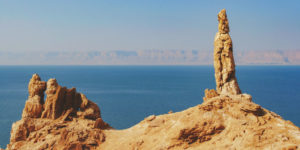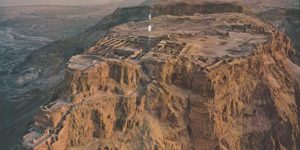Dead Sea Holy Experience: Take a Dip
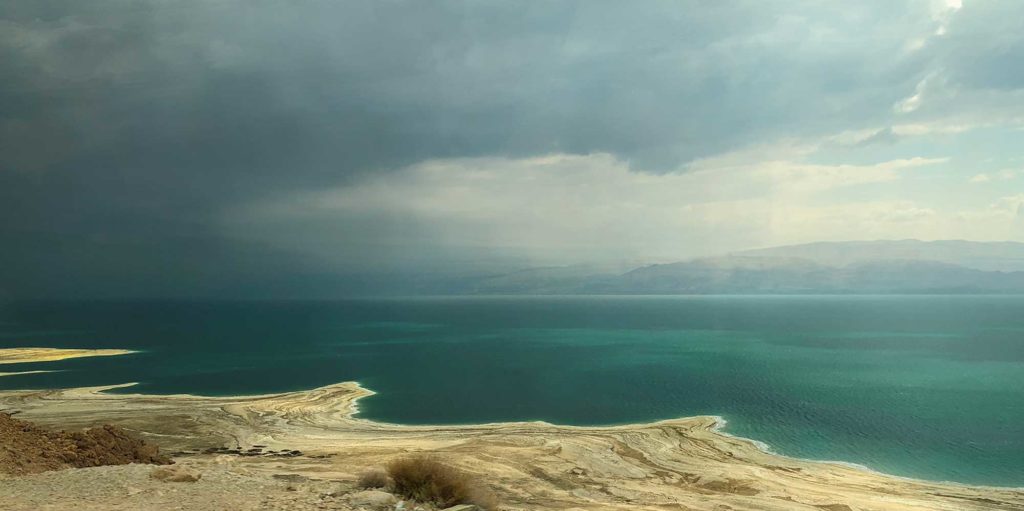
Dramatic Setting for Bible History
The Dead Sea was a theatrical backdrop for many events in Bible history. It is where the patriarch Abraham fought a war, where David hid from King Saul, where the prophet Ezekiel had visions, and near where the story of Masada took place.
For the Christian tourist, the Dead Sea is an important historical location. Though the Dead Sea itself is never mentioned in the New Testament, the sea and its surrounding area holds many insights into Christian history. It is considered one of the most sacred Christian sites in the Holy Land. A visit to the sea increases tenfold when you bring with you the knowledge of its past.
Biblical References
Only a few verses in the Bible specifically mention the sea. Yet, it is the setting for many stories and is characteristically a scene of judgment or of battle. One is in Genesis 14 which tells the story of Abraham’s rescue of his nephew Lot from the infamous cities of Sodom and Gomorrah, which were situated on the Dead Sea. The opening verses read:
At this time Amraphel king of Shinar, Arioch king of Ellasar, Kedorlaomer king of Elam and Tidal king of Goiim went to war against Bera king of Sodom, Birsha king of Gomorrah, Shinab king of Admah, Shemeber king of Zeboiim, and the king of Bela (that is, Zoar). All these latter kings joined forces in the Valley of Siddim (the Salt Sea). Genesis 14:1-4
An advancing army of Ammonites and Moabites apparently crossed a shallow part of the Dead Sea on their way to attack King Jehoshaphat:
After this, the Moabites and Ammonites with some of the Meunites came to wage war against Jehoshaphat. Some people came and told Jehoshaphat, “A vast army is coming against you from Edom, from the other side of the Dead Sea. 2 Chronicles 20:1-4
One mention is rather significant for those who watch for latter day prophesies to be fulfilled. Ezekiel has prophesied that one day the Dead Sea will be fresh water and fishermen will spread their nets along the shore.
He asked me, “Son of man, do you see this? Then he led me back to the bank of the river. When I arrived there, I saw a great number of trees on each side of the river. He said to me, “This water flows toward the eastern region and goes down into the Arabah, where it enters the Sea. When it empties into the Sea, the water there becomes fresh. Swarms of living creatures will live wherever the river flows. There will be large numbers of fish, because this water flows there and makes the salt water fresh; so where the river flows everything will live. Fishermen will stand along the shore; from En Gedi to En Eglaim there will be places for spreading nets. The fish will be of many kinds—like the fish of the Great Sea. Ezekiel 47:6-10

The Dead Sea is a valley full of natural tar pits, which was called the vale of Siddim. It became a place of refuge for King David in his flight from King Saul. The ancient fortress Masada, a Jewish stronghold in the time of King Herod, is located in the Dead Sea region as well.
Salty Dead Sea
Known in the Bible as the “Salt Sea” or the “Sea of the Arabah.” Other post-biblical names for the Dead Sea include the “Sea of Sodom,” the “Sea of Lot,” the “Sea of Asphalt” and the “Stinking Sea.” In the Crusader period, it was sometimes called the “Devil’s Sea.” All of these names reflect something of the nature of the lake. This inland body of water is one of the saltiest bodies of water on the planet, making for a harsh environment in which plants and animals cannot flourish. Hence its name. What accounts for this unusual condition? There are absolutely no outlets! A great volume of water pours into this area, but nothing flows out.
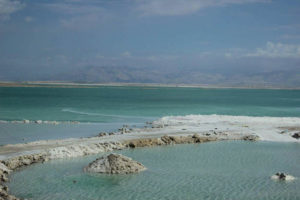
The Dead Sea is unique due to its high concentrations of salts and minerals. Nearly 10 times as salty as the world’s oceans and twice as saline as the Great Salt Lake in Utah, it is also rich in magnesium, sodium, potassium and calcium. The Dead Sea Works company on the southwest side of the lake harvests the valuable minerals from the water. Potash is the most valuable of those extracted today and is used in the manufacture of fertilizer.
Healing Waters
Because if its mineral concentration, the Dead Sea has attracted visitors for thousands of years. Aristotle, Queen of Sheba, King Solomon, and Cleopatra allegedly took dips in the mineral-rich waters, which have been said to relieve ailments ranging from psoriasis to osteoarthritis. Use of Dead Sea mud has been studied in connection with health benefits and healing properties for physical ailments.
It continues to this day to be a famous tourist spot because of its beneficial nature. The water feels heavy and oily. It is why it is a balm for the skin, and peace for the soul. Something almost magical happens when the water sweeps up its guests and buoys them in the well-known floating affect.
Rough and Rangy
Heading southeast out of Jerusalem, the entire terrain drops from roughly 3,400 feet above sea level at Jerusalem, to nearly 1,400 feet below sea level at the surface of the Dead Sea. In stark contrast to the rolling hills of Jerusalem is the terrain around the Dead Sea. It is desolate, arid, rocky, and rough.
It is in that rugged cliff face, on the banks of the Dead Sea, in this arid, desolate climate, that the Dead Sea Scrolls were discovered at the site known as Khirbet Qumran.
Dead Sea Scrolls
Among the most famous archaeological finds of the 20th century, the Dead Sea Scrolls include the better part of 1,000 ancient Jewish texts discovered in the Judaean Desert between 1947 and 1956. Bedouin shepherds unearthed the original clutch of Dead Sea Scrolls from cliff-side caves along the northwestern shores of the Dead Sea, close to the historic community of Qumran.
Subsequent to that first discovery, eleven different caves have been discovered at Qumran. In these caves were found thousands of fragments of manuscripts. Also found were many whole or mostly complete scrolls stored in jars.
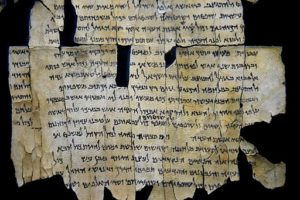
Among the cache of scrolls that we now call the Dead Sea Scrolls, are distinct types of material. First, is a collection of copies of the actual books of the Hebrew Scriptures. The copyists were preserving the texts of the Bible itself. Secondly, there were commentaries on these biblical texts. The commentaries show an interpretation of what would happen. They reveal the way the Essenes at Qumran believed because of the way they interpreted the prophecies of Isaiah, or the prophesies of Habakkuk, as well as the Torah itself.
The Dead Sea Scrolls are almost a complete set of all biblical books, as well as commentaries on many of them. “The Isaiah Scroll” is one of the most famous of the biblical manuscripts. The commentaries on Isaiah is also very important for our understanding of Jewish interpretation of Scripture in this period.
The scrolls have been dated from a remarkable period in history, spanning the 3rd century BC to the 1st century CE. This falls within the Second Temple Period, which saw a number of different Jewish sects develop. They also suggest the formative context for both Rabbinic Judaism and Christianity.
The Sea Today
The Dead Sea is full of contradictions: lush vegetation alongside an arid desert, ascetic monastery neighboring modern, luxurious hotels, the most sacred baptismal site adjacent to two demolished cities of sin. However, it is precisely these contradictions which awe and humble the Christian tourist, transforming the visit from a dip in the sea to an intense and holy experience.
The Dead Sea area is filled with attractions to make your Christian tour to Israel refreshing to your body as well as your soul. The most popular access points to the sea are the Ein Gedi Public Beach and the Ein Bokek Public Beach. Many of the beautiful spas and hotels alongside the Dead Sea offer therapeutic treatments for dermatological conditions. Hike beautiful Ein Gedi, a true oasis in the midst of the harsh desert, complete with waterfalls and exotic flora and fauna. Serious outdoors enthusiasts can make a day of mountain biking, climbing, and rappelling at Metzoke Dragot, an outdoors activity center. Christian visitors touring the Holy Land will not be disappointed with the ample supply of activities, both physical and spiritual.
Israel Tours
Together with our pastors, experience the sights and sounds of Israel; the homeland of our Lord and Savior! On our Christian Israel tours, you will have the opportunity of a lifetime to walk where Jesus walked and to explore the wonders of the land in which Jesus lived. From the Sea of Galilee to the shore of the Dead Sea, spiritual memories are just waiting to be made.

